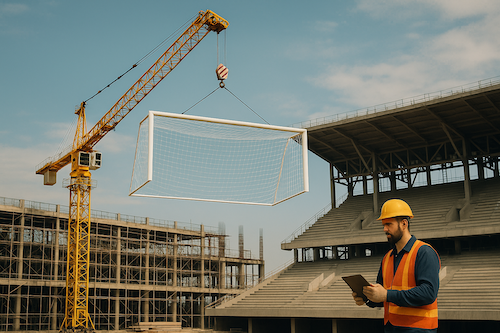A stadium can be the dream project for a construction company... or the nightmare that leads to millions of dollars in losses. The difference between a triumph and a failure is not only in the spectacular design, but in how every detail is planned, managed and executed.
Recent history is full of examples: while some projects become symbols of engineering and national pride, others have ended in bankruptcies, costly delays and unfavorable headlines.
What makes a stadium project successful? Experts in great works share lessons that apply both in Europe and in Latin America, where more and more cities are looking for stadiums of international stadiums.
The risk of the “iconic”
In theory, a stadium could be built relatively simply: stands, structure, roof and access. But in practice, customers—clubs, governments, investors—often ask for a “unique” design that turns the place into an icon.
That desire drives complexity and costs. Huge ceilings, innovative facades, multifunctional spaces and immersive experiences for fans... every detail adds risk.
A clear example is the new stadium proposed for Manchester United, which with 100,000 seats and an extended cover seeks to redefine the fan experience. Achieving that every spectator has good visibility and security isn't just a design challenge, it's a monumental engineering challenge.
In Mexico, just look at the case of the BBVA Stadium in Monterrey: its innovative design with a mountain-shaped façade set a trend, but it also involved enormous technical challenges in terms of time and costs.
Time is the toughest rival
Stadiums rarely have a flexible schedule. They must be ready For the start of the season, a Cup or even an Olympic Games. That means tight deadlines and constant pressure.
The projects they succeed in achieving usually have a common factor: a long pre-construction phase.
- They join the design team right from the start.
- Realistic construction strategies are defined.
- Key contracts are closed in advance.
At the London Olympic Stadium and at Arsenal's Emirates Stadium, this early stage was key to avoiding construction problems.
In Mexico, this applies the same: prior planning is what determines if the fans enter the stadium on the opening day... or if the incumbents talk about delays and cost overruns.
The supply chain: the critical link
Building a stadium is not like building an office. El number of vendors able to deliver critical packages (steel, roofs, facades, MEP) is very limited.
Experts agree: we must secure the supply chain early on. Even paying for their prior involvement may be the only way to ensure that the project moves forward.
At Everton's stadium, 80% of the cost was in just five packages. The team decided not to tender them competitively, but to choose trusted partners who could meet the complexity and the times.
Offsite construction: fewer people, more precision
La prefabrication and modular construction it's no longer a trend, it's a need.
- It makes it possible to reduce the number of workers on site.
- It speeds up the construction program.
- It improves quality and reduces risks.
In Everton, the use of prefabricated elements made it possible to reduce the maximum workforce of 3,000 people to 1,250. In a city like Liverpool (and the same is true in Monterrey or CDMX), gathering so much labor would have been practically impossible.
Of course: using offsite means closing designs much earlier and limiting changes. If the customer requests modifications in the middle of the process, the risk of cost overruns.
BIM and 4D: Build before you build
Today, no stadium can be built without advanced digital models. El BIM 4D allows:
- Detect interference before work.
- Plan construction sequences.
- Show the customer how each space will look and work.
In Everton, a 3D immersive room was even used where contractors virtually walked the project before executing it. This made planning more collaborative and reduced surprises.
In Mexico and LATAM, where more and more projects are seeking certifications and transparency, this technology is not a “plus”, it's a competitive obligation.
Risk: who bears it?
The contractual model is decisive.
- El turnkey design and construction may look attractive, but it leaves all the risk on the contractor. Many have fallen along that route.
- El Construction Management gives the customer more flexibility, but also more cost uncertainty.
The key is in allocate risk fairly and, above all, build trust between client and contractor. In Everton, despite the changes and the pandemic, it was possible to deliver on time thanks to that alignment.
What lessons apply in Mexico?
- Avoid whimsical designs that unnecessarily complicate the work.
- Start with a solid pre-construction plan.
- Tying up the few critical suppliers early on.
- Integrate prefabrication and BIM to gain speed and precision.
- Define a contractual model where risks are balanced.
In a country where stadiums are not just sports venues, but cultural and political symbols, these lessons are pure gold.
Conclusion: From Dream to Legacy
A stadium is always more than concrete and steel. It is a place where a city meets, a symbol for generations and a project that will mark the reputation of a construction company forever.
Doing it right involves combining strategic planning, technological innovation, risk management and a trusted team.
In soccer, not everyone can be a champion. In the construction of stadiums, neither. But those who apply these lessons are much more likely to deliver a project that is not only a triumph for the client, but also a legacy for the city.

